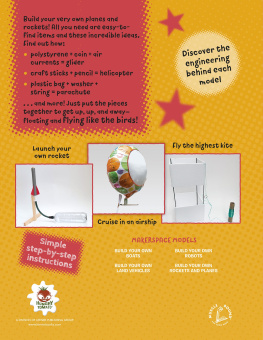To teachers everywhere,
Thanks for inspiring children every day.
Copyright 2012 by Bobby Mercer
All rights reserved
First edition
Published by Chicago Review Press, Incorporated
814 North Franklin Street
Chicago, Illinois 60610
ISBN 978-1-61374-086-6
Library of Congress Cataloging-in-Publication Data
Mercer, Bobby, 1961
The flying machine book : build and launch 35 rockets, gliders, helicopters, boomerangs, and more/Bobby Mercer.1st ed.
p. cm.
Summary: Shows readers how to turn rubber bands, paper clips, straws, plastic bottles, and index cards into amazing, gravity-defying flyers. Each project contains a material list and detailed step-by-step instructions with photos. Mercer also includes explanations of the science behind each flyer, including concepts such as lift, thrust, and drag, the Bernoulli effect, and more-- Provided by publisher.
ISBN 978-1-61374-086-6 (pbk.)
1. Paper airplanes. 2. Flying-machines--Models. I. Title.
TL778.M47 2012
745.592dc23
2011041174
Cover design: Andrew Brozyna
Interior design and illustrations: Scott Rattray
Interior photographs: Bobby Mercer
Printed in the United States of America
5 4 3 2 1
Contents

Acknowledgments
Thanks to all the people who helped turn an idea for free flying machines into this book. Kathy Green for helping this book find a home. Jerome Pohlen and the creative people at Chicago Review Press for making it look great. Robert Frost and Greg Robinson for lending me their real flying experience. But most of all, thanks to my wonderful family. Michele, you are amazing and understanding when I dont put the scissors back. Nicole, for helping me build many of the flyers in this book. Jordan, thanks for making everyone in the house smile. A special thanks to Molly, Belle, and Sally, our three lovingly psycho cats, for chasing flyers all around the house and the great outdoors.

Introduction
A bird inflight is an inspiring beauty to behold. Making and flying things with your own hands is just pure fun. We have all enjoyed the feeling of watching our creations take off. Seeing paper airplanes being tossed about is a joy. Water balloons arcing gracefully toward an intended target make us smile.
The flying projects in this book range from very easy to difficult, and everybody should to be able to find a favorite. Each fun flyer project is designed to let you experiment with, tweak, and explore the wonderful world of flight. The materials required for these flyers are everyday items found in most homes and classrooms, so there is no expensive stuff to buy. Just go have fun!

1
Flight School
The ability to fly has amazed people since time began. The earliest humans watched birds soaring in the sky and dreamed of joining them. Kites were probably humankinds first attempt to reach the skies. The Chinese first started flying kites around 400 B O, for ceremonies and just for fun.
Leonardo da Vinci was the first person known to seriously study flight. His drawings described his theories on bird flight. Da Vinci even drew pictures of imaginary flyers that would allow a person to fly under his or her own power. Although none were built for over 400 years, his designs inspired the invention of the helicopter.
In the late 1700s, hot air gave human-powered flight a lift. People discovered that hot air rises, so a bag filled with hot air will float. This led to the invention of the hot air balloon. Hot air balloons soared over Europe in the 1780s, giving people the opportunity to realize their dreams of flying through the air.
Around 1800, Englishman George Cayley took flying in a new direction when he discovered the modern airfoil. Cayley, often called the Father of Aviation because of his studies, is acknowledged as the first person to realize that the battling forces governing flight were lift, thrust, drag, and weight. He also built the first glider capable of holding a person, and that first flyer was a 10-year-old boy. Cayley also experimented with rudders and flaps, just like you will on the flyers in this book.
Of course, the Wright brothers pioneered powered flight, but Cayleys work is more closely related to the flying machines you will be building.
Each chapter in this book focuses on one type of flyer: helicopters, rockets, boomerangs, and different types of gliders. Not all the flyers are easy to make, and many take practice to perfect. But with a little patience, your flyer can reach the sky.
The Bernoulli Principle
Daniel Bernoullis dad, a brilliant mathematician, never wanted his son to study math. Instead, he wanted Daniel to study medicine because it paid better. Daniel did go into medicine but never forgot his love of math. As a math professor in his 20s, he discovered a principle that combined his interests in math, science, and medicine, and it made him both famous and rich.
At the time of his discovery, Bernoulli was working with blood. He wanted to know about the relationship between blood pressure inside an artery and the speed of the blood through the artery. He soon realized that if he punctured a tube carrying a fluid with a thin pipe, the fluid would go up the pipe. And more interestingly, how far it rose (due to pressure) was related to the speed of the fluid past the end of the pipe. For the next 150 years in Europe, physicians would measure blood pressure by piercing a patients artery with a thin glass tube. Luckily for you and me, we have a safer way to measure blood pressure today.
Even though Bernoulli was working with a liquid, the same principle works for gases such as air. Scientists classify both liquids and gases as fluids, since they flow.
You can see Bernoullis principle at work by doing this simple experiment. Hold a long strip of paper (a dollar bill works well) tucked tightly just under your bottom lip. Blow hard, directly outward, and the strip will rise. Fast-moving air creates a low pressure above the paper, and the strip lifts.
Now, lets put Bernoullis principle to work and learn more about the science of flight.
Four Forces
Flight is governed by four forces: lift, thrust, drag, and weight.
Lift
Thanks to Mr. Bernoulli, we now know that as air moves over an airfoil (airplane wing, helicopter rotor blade, etc.), the air over the top has to travel a greater distance. Because it travels a greater distance in the same amount of time, it moves faster than the air moving under the wing. Faster air has lower pressure than slower air. High pressure under the wing will lift the wing up toward the area of lower pressure.

Thrust
Thrust comes from the engine on most traditional airplanes, or from the rocket engine on a rocket. Thrust causes the plane to fly forward. However, since you wont be using engines in this book, your flying machines thrust will come from other sources. You will use muscle power and stretched rubber bands for most of your flyers. After you launch a flyer, only inertia keeps the flyer moving forward.
Next page















